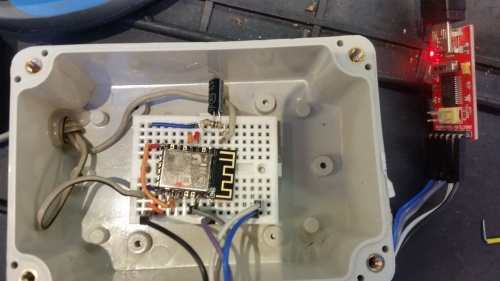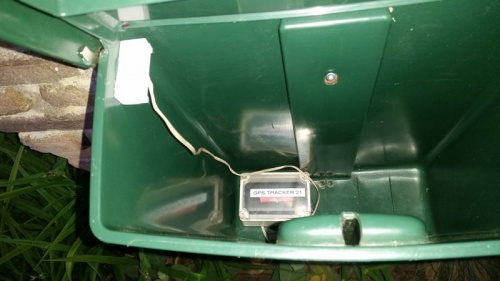Difference between revisions of "EasyNotifications"
Sandominion (talk | contribs) |
Sandominion (talk | contribs) |
||
| Line 53: | Line 53: | ||
* Enable '''Sleep on connection failure''' | * Enable '''Sleep on connection failure''' | ||
* Set message delay to 0. | * Set message delay to 0. | ||
| − | * Add an [[EasyNotifications# | + | * Add an [[EasyNotifications#Email Notification|email notification]]. |
* Enable rules. | * Enable rules. | ||
* Create a rule that mails you on system boot, like this: | * Create a rule that mails you on system boot, like this: | ||
Revision as of 01:43, 8 August 2018
Contents
ESPEasy notifications
ESPEasy notifications are to be used in combination with rules.
For example, to send a message on system boot use a rule like this:
on System#Boot do notify 1,system_is_started endon
Note: Use v2.0.0-dev11 or higher. There was a bug in dev10 and older versions that lead to crashes.
Creating a paper-mail to email gateway
I used notifications in combination with Deep Sleep to create a system that notifies me when I have new paper mail in my actual mailbox:
Hardware
- Core: A bare esp-12-f. Not a development board, so it has no voltage regulator and no usb-to-serial interface that draws current while sleeping.
- Casing: Google for Waterproof Clear Cover Plastic Electronic Box Project
- Magnetic microswitch: Google for something like 10pcs/lot Wired Door Window Magnetic Sensor Switch
- Use a GOOD and high temperature hot-glu gun like the Dremel 940. This saves a lot of frustration and allows you to make everything nice and solid.
For power I used an old powerbank, those you use to charge your phone. Most power-banks use lithium cells that are a perfect 3.3 volts. And they are easy to charge as well. :)
Wiring
- You need to connect some extra pins to VCC or GND if you use a bare ESP-12-f, google for this. :)
- Connect D0 to vcc, to ensure the device goes into deep sleep. (connect to GND to disable deep sleep)
- Connect the magnetic switch:
- Connect one side of the magnetic switch to GND.
- Connect the other side of switch it to the - side of a capacitor (4u7), with a 1 meg. resistor in parallel.
- Connect those the the RST pin.
This will wake up the ESPEasy from deep sleep when the magnetic switch is closed.
An awesome "schematic" of the switch-part:
[ GND ] --- [ magnetic switch ] -----+- [ 4u7 capicitor ] --+-- [ ESP8266 RST pin ]
| |
---[ 1M resistor ] ---
The capacitor will make sure it doesnt stay in reset-mode if the switch closed for a longer time.
ESPEasy settings
- Enable deep sleep with a sleep time of 0 seconds. (this way it only wakes up manually by the switch)
- Enable Sleep on connection failure
- Set message delay to 0.
- Add an email notification.
- Enable rules.
- Create a rule that mails you on system boot, like this:
on System#Boot do notify 1 endon
- Consider compiling ESPEasy with FEATURE_ADC_VCC. (enable it in ESPEasy.ino) This way you can add a sysinfo task that sends the battery level to your homecontroller, every time it wakes up.
Email Notification
ESPEasy can’t send Emails using popular providers like Gmail.com or Yahoo.com…
… because most of common Email service providers stopped support for non-secure SMTP (w/o SSL) around 2014 but the Email-Notification inside ESPEasy does not support SSL due to limited resources. [1]
Unless you have an own mailserver inside your local network you should:
CREATE a special Email account for ESPeasy without SSL
at one of the rare Email providers still offering SMTP with no or optional SSL (e.g. SMTP2go.com, smart-mail.de). Otherwise you won’t be able to use the Email-Notification from ESPEasy at all!
Afterwards inside the Web-configuration of ESPEasy from the menu select item "Notifications" and choose one table row (in this example No.1) to "Edit" with the following Notification Settings:
| Contend | Example 1 | Example 2 | Description |
|---|---|---|---|
| Notification: | Email (SMTP) | Type of notification | |
| Domain: | smtp2go.com | smart-mail.de | Web address of Email service provider |
| Server: | mail.smtp2go.com | smtp.smart-mail.de | full server name to deliver Email via SMTP |
| Port: | 25 | SMTP-Connection port is traditionally same | |
| Sender: | ESP123@smtp2go.com | ESP123@smart-mail.de | full Email address for the device to be used |
| Receiver: | JohnDoe@gmail.com | Who should get the Email? | |
| Subject: | Message from your ESPEasy | Topic in Email headline (fixed) | |
| User: | ESP123@smtp2go.com | ESP123@smart-mail.de | Username to use to log in to the SMTP Server (normally same than E-Mail address for the device to be used) |
| Pass: | 2S€cr€t4you | 2S€cr€t4me | Password to access devices Email account |
| Body: | Device is in duty since %uptime% minutes. | Default text is send only if command "notify X" is called without optional text for the body | |
| Enabled | <hook> | Needs to be active | |
Now you can use the command e.g. like:
Notify 1 Notify 1, This_is_an_automatic_generated_message
The general syntax is:
Notify <position>, [message_in_the_body]
Where <position> is the No. of notification 1...3 in the list of all Notifications and [message_in_the_body] the optional text to replace the default text from "Body:" in Notification Settings.
Might-be-useful rule example:
On Time#Initialized do //connected to WiFi & TimeServer notify 1, Connected_After_Reboot //Send Email endon
Some more hints:
- In [optional] text for the body message avoid special characters or space (you might use “_” instead).
- The "Unit Name" from "Main Settings" (if defined) is used as Email Sender Name (usually displayed to Receiver with Email address).
- If you need to differ between subjects you could create (almost same) Notifications for each subject.
- If you don't geht out any E-Mail check if your Internet router is configured to enable Port 25
- If you still have problems chek if you have checked the check box labeled "Enabled" inside Notifications Settings.
- Hope that the Email provider of your choice doesn’t stop providing SMTP w/o SSL.

